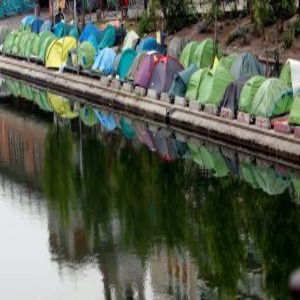
Nowhere can you get more explicit pictures of uncontrolled immigration in Paris than at the Porte de la Chapelle metro station in the 18th arrondissement?
Or around the Millénaire supermarket on the banks of the Saint-Denis canal on the outskirts of the 19th arrondissement where nearly 2,000 migrants have literally pitched camp.
French media have already nicknamed the rapidly developing shanty town “the new Calais” after the infamous “jungle” camp in the northern part of France, which was burned down in 2016.
The migrants, numbering about 3,000, mostly hail from Nigeria, Sudan, Eritrea, Ethiopia, although other countries are represented. The whole lot has crammed their tents into three wretched tented camps in Paris.
The next city gateway or ‘Porte,’ as they are popularly known, is Porte d’Aubervilliers apart from Porte de la Chapelle, and it hosts lots of migrants. Even though many camps have been cleared, there remains one that has around 200 migrants, mainly children and women.
In contrast with the squalor and sordid nature of the Porte de la Chapelle camps, Porte d’Aubervilliers could almost be termed as ‘up market’.
These tents are the best way of displaying pictures of uncontrolled immigration in Paris, with tents crammed together on a broad and smooth path. Ironically, the tents are surrounded by apartment blocks and offices, and the location is experiencing rapid urban restoration with the squalid-looking tents in the background.
In these tented mini-cities, many migrants are fleeing impoverished or war-torn countries, and the conditions that they live in are nothing short of appalling.
As they drag on with their miserable existence, these migrants have only one thing in mind: their next appointment with the immigration officials. Sadly, after the first meeting, the immigration authorities send the migrants on their way to fend for themselves for months.
One of the main migrant camps next to the Porte de la Chapelle metro station in the 18th arrondissement is tolerated by the authorities probably because it is mostly out of sight.
The camp lies under an intersection of the périphérique where many multi-lane highways are heading to the suburbs and the constantly congested Paris inner ring road.
The camp is invisible to motorists zooming overhead, blissfully unaware of the misery that is just a few feet beneath them.
The situation in the camps is gloomy, to say the least, with lots of fighting, especially when the food is not enough. Charities offer food just like in most of makeshift migrant camps in Paris.
To make matters worse, the drug problem has infested the camps, and trouble from the drug peddlers is a constant threat to the migrants.
The drug dealers are ruthless, and at times, they target young immigrants. By giving the migrants free drugs, they get them hooked, knowing very well that the addiction will add them to the list of new clients.
Now, what happens when the migrant camps grow too big or attract undue attention, especially from the media? In most cases, the authorities, with police in riot gear in tow, send in buses for transporting them to temporary quarters in requisitioned hotels or gyms.
Sadly, this is always a temporary solution, and the migrants go back to the streets within no time.
What contributes to the rapid growth of these tented camps is that under the French system of asylum application or legal status, migrants attend an initial interview. Then, after the interview, they are sent on their way and informed that they would get an SMS message to summon them to another meeting to decide their fate.
Unfortunately, that interview comes after months or even more than a year later. The saddest part is that during that waiting period, the migrants have to support themselves, and for most, it means ending up in a tent.
This is the story of most of the migrants living in the tents: waiting and hoping that the all-important SMS will come and with it the hope that they will soon have a real roof over their heads.
Critics of the authorities claim that this treatment is done deliberately to dissuade other migrants from coming to France.
But if this theory is true, then it is failing dismally because every day sees more and more migrants arriving in Paris.
While the authorities spend millions on housing migrants annually, many end up falling through the cracks, and circumstances force them to live rough in the streets and tents.
Unless the migrant issue gets a lasting solution, and as long as the migrants keep on pouring in, the chances are high that we will continue to see lots of pictures of uncontrolled immigration in Paris.
